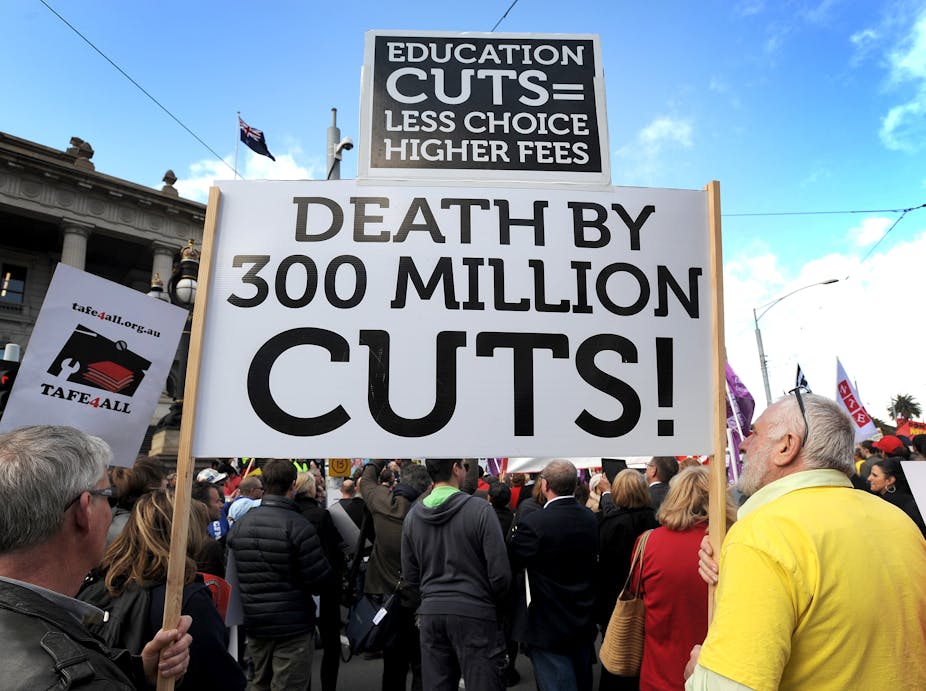I was sitting in a session at the Institute of Public Administration Congress recently where Greg Hywood, the CEO of Fairfax, boldly announced that the public sector simply did not understand cuts. Not, he argued, in the way that those facing financial crisis in the private sector did. I waited for the crowd to storm the stage, but instead they sat politely listening, albeit with much fidgeting amid the shock.
There is no doubt that big cuts to public services are the flavour of the month – not just in Australia, but also in many parts of the world. The recent announcement that the Queensland government would cut 14,000 jobs, followed on from news around the country that the knife was coming out to hack away at the bloated bureaucracies that characterise our state governments, or so they say.
On the face of it, deep cuts in tight budgetary times might make sense. Fewer people employed by government should reduce outlays and help get the house in order. But there are plenty of costs associated with this strategy. And here we are not just talking about what happens in the immediate aftermath, but in the medium to long-term as well.
Combining this with major pending experiments with outsourcing and we start to see a complex government “strategy” emerging which relies heavily on externalisation.
But why might we want to rethink cuts? Here are a few basic reasons.
First, redundancies don’t come cheap and they represent a big one-off financial cost; couple this with potential increases in the unemployment queue (although this cost gets passed on to the Commonwealth).
Second, we tend to lose important skills and knowledge that frankly, we are never that great at holding onto during major downsizing events. Why? Because many who take lucrative packages might be high performers or highly marketable and take a package because they know they can pick up work relatively easily.
Third, we find out too late that the skills and expertise we needed have walked out the door, and we desperately buy it back using short-term contracts or consultancies at much higher prices. Often, ironically, from the same people we just fired.
Finally, we create a range of effects for those left behind in the public service. Work intensification, “survivor syndrome” stress, reduced motivation and commitment are all potential effects.

Big cuts work in the short term to reduce some costs, but will they really solve government’s problems? At what stage do we have a more sophisticated strategic debate about what government should do, and then how they should go about doing it? I’m not advocating a return to the big in-house production model that characterised government in the past, but do we really have a plan besides cutting? Are we across the potential effects down the line?
Focusing on the numbers alone doesn’t tell us anything – in fact, it is nonsensical. A better question is: what is it that we actually want government to do? And then, how should they go about doing it?
Deep cuts, with numerical targets coupled with outsourcing agendas are often politically motivated, and ideologically driven with a strong assumption that the private sector always does it better and that public servants are costs to be managed. How about doing things differently instead of, or even alongside, some reductions?
In the United States, the General Services Administration agency launched the Great Ideas Hunt and took the radical step of asking its employees how it could save money. Hardly rocket science, but I suspect such moves are pretty rare here. The GSA got more than 600 ideas from 500 employees and asked them to vote on the best. The top five are being implemented and will save the agency $US5.5m per year. Forty or so more are likely to be rolled out.
And what are we talking about here? Basic things – moving from paper to web-based survey for clients, or using a survey tool from another agency rather than paying a consultant. Involving staff in addressing the problem can also make them more motivated and engaged.
I’m not suggesting that there is no room to trim, often there is, but often these deep cuts are politically motivated and not managerially sensible. Thinking about the various costs and benefits is the key here, not target-driven reductions. Unfortunately, these concerns rarely get the attention that they need and we go through cycles of cutting, rebuilding, and cutting, without thinking deeply about what we want government organisations to actually do, and how.
Maybe it is time to change the conversation.

